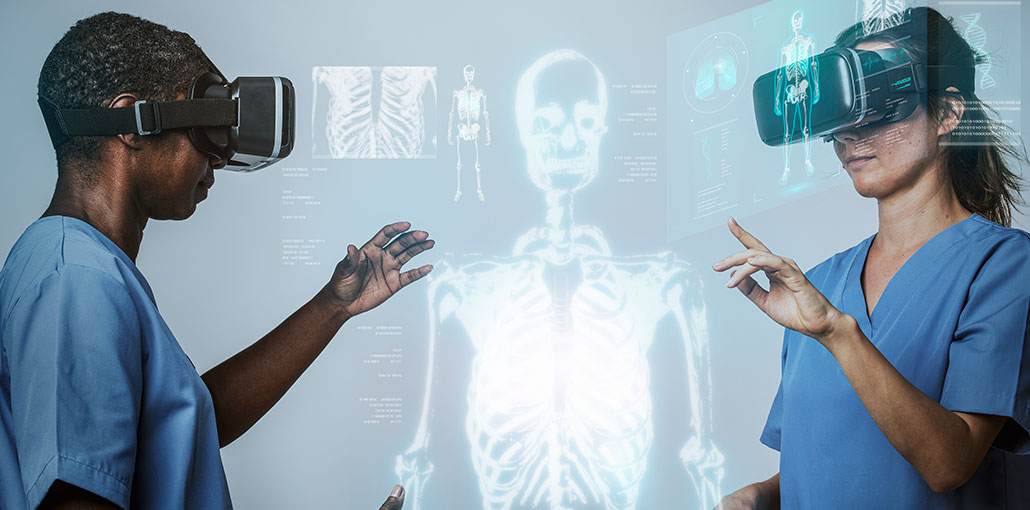Augmented reality (AR). And virtual reality (VR) is changing the face of healthcare and other industries. These 18 companies are among the most prominent in virtual and augmented realities in the medical sector.
Defining Augmented Reality
Augmented reality is a technology that combines real-world elements and virtual ones. One could go to a tradeshow, point their smartphone at a display and activate AR to view a computer-generated product.
This is especially useful when people want to get excited about prototyping or help them see the potential of an item that’s not yet finished.
AR vs. VR: What’s The Difference?
Another buzz-worthy technology is virtual reality. It continues to attract attention and fascinate people both in and outside the medical sector. While AR and VR share some similarities, they are not the same.
Both technologies are able to respond to changes in real-time, such as the movement of a person. The technologies require very low latency in order to function seamlessly for their users. VR and AR also aim to provide experiences that are difficult to replicate in the real world. IKEA, a home furnishing company, offered an AR app that enabled people to place virtual furniture in their homes and check the dimensions.
AR may include some elements of the environment, but VR is designed to provide a fully immersive experience. VR begins when the headsets are put on. The VR experience is a way for people to see the world through the headset. However, the AR experience enhances the environment.
The difference between AR and VR is the fact that AR has more applications in other industries such as manufacturing. For workers on the factory floor, it is not practical to wear all VR headsets. They may instead use AR-enabled glasses or goggles that are lighter and easier to help with tasks such as quality assurance and assembly.
The Potential, Advantage and Use Cases for AR and virtual reality in Healthcare
Markets and Markets analyzed the projected growth of AR/VR in healthcare between 2017-2025. The company expects to experience a combined annual growth rate in excess of 30.7% over the study period.
VR and AR have a lot of potential in healthcare. But how can people actually use them? It could make surgical planning easier. These high-tech solutions could make surprises less likely for even the most experienced surgeons.
Researchers also investigated VR as a way to educate patients prior to their surgery. A person can view a digitalized version of their brain and see the problem that a surgeon must fix. They also have instructions on how to do it.
Virtual reality and Augmented Reality can be used to teach patients about the procedures that they require. It also helps surgeons plan their operations, which makes them less likely to face unexpected or unprepared situations. Some technologies allow digital information to be displayed on the patient’s body in real-time.
These technologies may also improve medical school training. Johns Hopkins University researchers began an AR project where medical students could trade their anatomy apps to AR. An augmented reality tool showed an inside view of the student’s body overlaid on top. A gesture-sensitive interface was also available, which allowed users to interact with the AR representation.
Also read: Best 10 applications for Machine Learning in Healthcare
The Top Augmented and Virtual Reality Companies in Healthcare
Virtual reality and medical augmented reality promise a lot. These companies are committed to being at the forefront of VR and AR healthcare.
1. FundamentalVR
Founded: 2012
Location: London, United Kingdom
Funding to Date: $9.6 million
The company provides flight simulator-like training to surgeons. This allows surgeons to practice, rehearse and improve their surgical skills in a controlled environment with haptic elements that provide tactile feedback. The company offers AR tech through Microsoft’s HoloLens technology. The simulations allow users to collaborate.
2. Karuna Labs
Founded: 2016
Location: San Francisco, California
Funding to Date: $3 million
Virtual reality simulations are used to treat chronic pain. The treatment can be done at home or in a clinic. The treatment program can be done in a clinic and lasts between four to twelve weeks depending on the patient’s needs.
3. OxfordVR
Founded: 2016
Location: Oxford, United Kingdom
Funding to Date: £13.2 million
OxfordVR uses virtual reality to alleviate the symptoms of fears and mental disorders. The fear of heights simulation, for example, reduced patient anxiety by 68% in just two hours.
4. Augmedics
Founded: 2014
Location: Arlington Heights, Illinois, and Yoqneam, Israel
Funding to Date: $25.1 million
The company has received FDA 501(k) clearance for its headset. The company will start distributing headsets in the U.S. in 2020. It plans to expand its use beyond spinal surgery soon.
The company calls vision “the first augmented real guidance system for surgery.” This technology allows surgeons to view the anatomy of patients through tissue and skin using a 3D representation. The accuracy rate of the VR headset when surgeons were placing spinal screws into cadavers was 98.9%.
5. Surgical Theater
Founded: 2010
Location: Los Angeles, California, and Cleveland, Ohio
Funding to Date: $9.6 million
Precision VR is a surgical rehearsal platform for neurosurgical procedures that Surgical Theater has created. This allows for better planning. This simulation is available to patients and their healthcare providers, but it’s not like other medical technology companies. A VR simulation can be used to show the procedure, such as when a patient is facing a brain tumor operation.
6. EchoPixel
Founded: 2012
Location: Santa Clara, California
Funding to Date: $14.3 million
True3D, an AR platform for healthcare, is offered by the company. It allows users to visualize and interact with specific organs and tissues. The technology also allows users to view medical imaging results and holograph-like images.
7. Medivis
Founded: 2016
Location: Brooklyn, New York
Funding to Date: $2.5 million
The company uses medical augmented reality and artificial intelligence (AI), to provide presurgical information and details about a person’s anatomy. The company envisions a future where healthcare professionals can no longer be limited by 2D screens and instead present information and tools in 3D representations.
8. Health Scholars
Founded: 2017
Location: Westminster, Colorado
Funding to Date: $17 million
Health Scholars VR training solutions scale lifesaving experiences using AI-enabled VR simulations, performance assessments, and custom-designed VR training for clinicians and first responders. The VR simulations provide emergency care training in adult and pediatric settings. This platform provides the best interactive, measurable, and accurate training experience.
9. Vicarious Surgical
Founded: 2015
Location: Charlestown, Massachusetts
Funding to Date: $30 million
This company uses virtual reality and a surgical robot to create minimally invasive procedures.
10. Touch Surgery
Founded: 2013
Location: London, United Kingdom
Funding to Date: $19.5 million.
Touch Surgery has more than 200 virtual surgical simulations and videos in 17 specialties. Learners can access them from anywhere with an internet connection.
11. Proprio Vision
Founded: 2016
Location: Seattle, Washington
Funding to Date: $30 million
The company combines human vision and computerized technology to enable surgeons to see the body in new immersive ways, increasing their success rates during procedures.
Also read: Artificial Intelligence In Healthcare: How it is Changing the Industry
12. ImmersiveTouch
Founded: 2005
Location: Chicago, Illinois
Funding to Date: $2.1 million
ImmersiveTouch creates 3D virtual realities models from patient-specific medical imaging data.
13. OSSO VR
Founded: 2016
Location: Boston, Massachusetts
Funding to Date: $2 million
This company is a specialist in virtual reality for surgical training and assessment. This company offers immersive VR experiences with haptic feedback.
14. SentiAR
Founded: 2017
Location: St. Louis, Missouri
Funding to Date: $7.4 million
The company uses medical augmented reality to create a holographic representation of the patient’s anatomy. This image is projected over the patient during interventional procedures such as cardiac arrhythmias treatment in a catheter laboratory.
15. Medical Augmented Intelligence
Founded: 2016
Location: Taipei City, Taiwan, and Fairfax, Virginia
Funding to Date: $500,000
Medical Augmented Intelligence offers immersive virtual reality training in anatomy, acupuncture, and other subjects. It also offers “digital twin” models to assist patients with education. In less than 30 seconds, the patient-based models convert 2D images into VR models.
16. HoloAnatomy
Developed: 2016
Location: Case Western Reserve University and Cleveland Clinic
Cost: HoloAnatomy is available for free. However, the Microsoft HoloLens device which enables it costs $3,000.
This list includes the most prominent augmented and virtual reality healthcare providers, but this entry is different as it’s an application. A Microsoft HoloLens can be used to access a digitalized and interactive anatomy curriculum.
17. SyncThink
Founded: 2009
Location: Palo Alto, California
Funding to Date: $3.6 million
SyncThink spent 15 years conducting clinical research in order to create the virtual reality headset, EYE-SYNC. It monitors a person’s eye movement and allows clinicians to determine if they have a head injury.
18. XR Health
Founded: 2016
Funding to Date: $15.5 million
XRHealth was the first company to develop virtual reality clinics. These clinics provide remote care for patients in the United States. It is also covered by all major insurance companies and medicare. Virtual support groups are a unique feature of VR therapy. Patients with similar conditions can connect anonymously with top-ranking physicians who moderate the group remotely.
An Exciting Future for AR and VR in Healthcare
Virtual reality and augmented reality have revolutionized the medical industry even in their early stages. These top augmented reality companies are a testament to the pioneering views of many of those who have worked tirelessly to perfect these technologies.
Even if these technologies aren’t used in healthcare, providers should keep up to date with the latest developments. AR and VR will soon be as common to healthcare professionals as many tools and techniques they cannot imagine not having.










Leave a comment